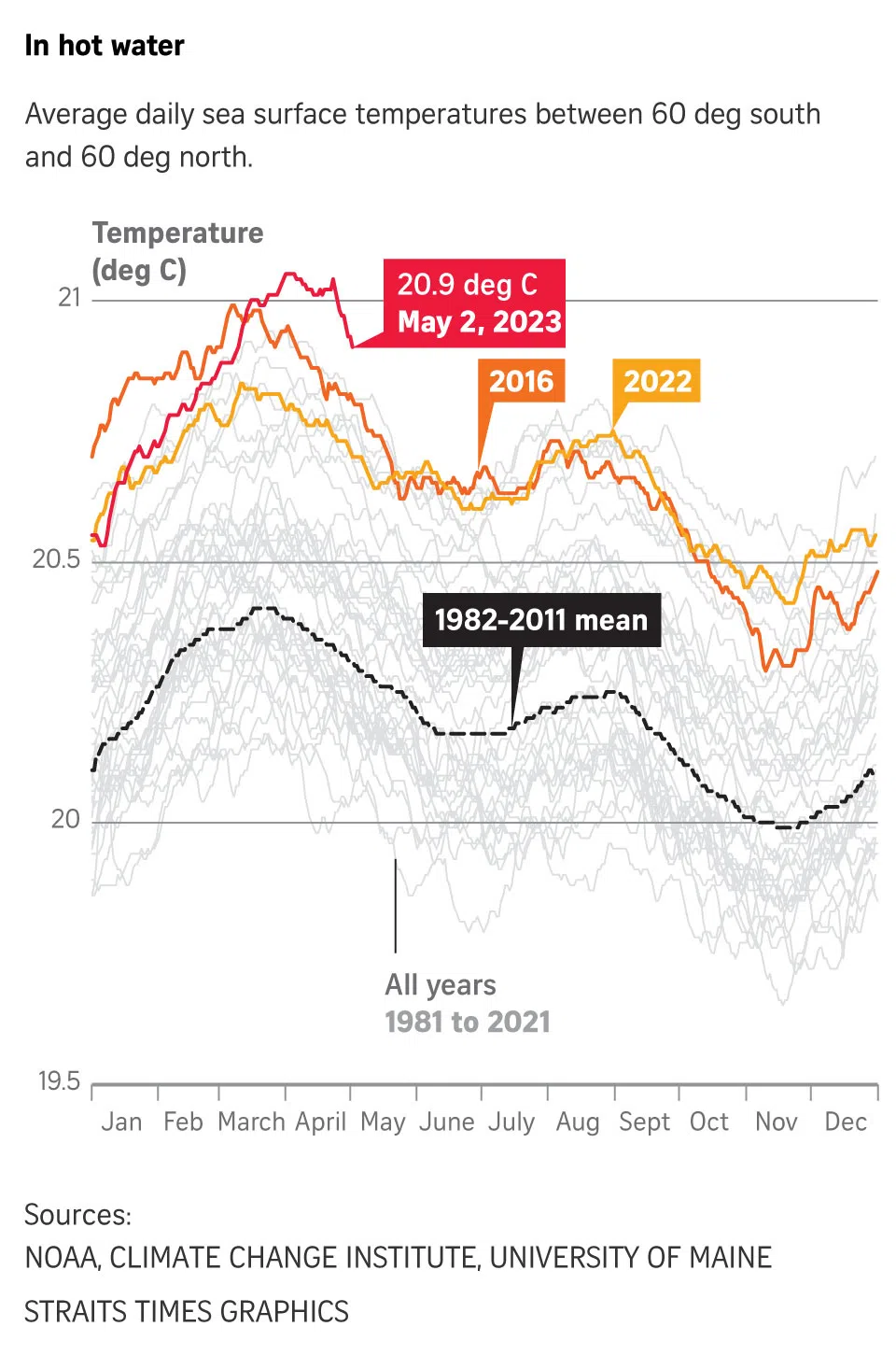Record ocean temperatures trigger concern as El Nino looms
Sign up now: Get ST's newsletters delivered to your inbox

Global average ocean surface temperatures hit a record 21.1 deg C in early April.
PHOTO: AFP
Follow topic:
SINGAPORE - Ocean surface temperatures hit a record in April and remain at near-record levels, worrying some scientists who fear even warmer temperatures later in 2023 during a predicted switch to an El Nino event in the Pacific Ocean.
Global average ocean surface temperatures – measured between latitude 60 deg south and latitude 60 deg north – hit a record 21.1 deg C in early April, exceeding the 21 deg C record set in 2016, which was an El Nino year. It was also the highest since satellite records began.
The concern is that warmer oceans could trigger more extreme storms,
The rapid return to warmer ocean temperatures – suppressed by the cooling effects of a three-year La Nina event – is also a reminder of the impact of climate change, which is heating up the oceans at a worrying pace.
“Large swathes of the world’s oceans are warm. Unusually warm. The heat this year is likely to break records,” said professor of oceanography Moninya Roughan at the University of New South Wales (UNSW) in Sydney.
Writing in The Conversation on April 26, she explained that during La Nina, cooler water from deep in the ocean rises to the surface, acting a bit like an air-conditioner by cooling things down. El Nino is like turning the air-con off.
“When you run your air-conditioner, you’re masking the heat outside. It’s the same for our oceans. La Nina brought three years of cooler conditions, while global warming continued apace. Now we’re likely to see the heat roar back.”
It is the speed of the increase in warmth in recent weeks that has scientists both intrigued and concerned.
“This has got scientists scratching their heads,” Professor Mike Meredith of the British Antarctic Survey told The Guardian in late April. “The fact that it is warming as much as it has been is a real surprise, and very concerning. It could be a short-lived extreme high, or it could be the start of something much more serious.”
“Daily global ocean surface temperatures since April are indeed off the charts,” Dr Agus Santoso from the UNSW Climate Change Research Centre told The Straits Times.
“This could be driven by the global-scale warming or very intense warming at certain locations, or both, such as the warming off Peru which can eventually spread westward as part of an evolving El Nino,” he said, pointing to intense ocean warming off parts of South America.
Global average ocean surface temperatures have eased a bit to 20.9 deg C on Tuesday, the latest data available, which is well above all other years in the past decade for this time of year. The data comes from the National Oceanic and Atmospheric Administration in the United States.
While 0.1 deg C or 0.2 deg C might not sound like much, it takes a lot more energy to heat up water than air; and as oceans cover about 70 per cent of the planet’s surface, that is a tremendous amount of heat that has been absorbed.

Without the oceans, the planet would be much warmer, because oceans have been soaking up more than 90 per cent of the excess heat caused by global warming.
That heat content is growing, triggering more severe marine heatwaves and concern for sea life, as well as impacts on weather and ice caps.
A study published in January 2023 found that 2022 was the hottest year
Heat content in the oceans exceeded the previous year’s levels by around 10 zettajoules – equivalent to 100 times the electricity generation worldwide in 2021, according to the study’s authors.
Scientists’ main concern now is the impact of the next El Nino, which the United Nations said on Wednesday was increasingly likely to develop in the coming months, fuelling possibly new heat records.
The World Meteorological Organisation estimated there was a 60 per cent chance that El Nino would develop by the end of July, and an 80 per cent chance it would do so by the end of September. But how strong it would be remains unknown.
El Ninos impact weather systems around the globe and typically bring hotter and drier conditions to South-east Asia and Australia. The last El Nino in 2018 to 2019 triggered heatwaves and severe drought in Australia that fuelled record bush fires.
Professor Benjamin Horton, director of the Earth Observatory of Singapore at Nanyang Technological University, said the equatorial Indo-Pacific region is helping drive the recent spike in ocean surface temperatures.
Data from this region “clearly signifies that we are very likely to experience an El Nino soon, perhaps a very strong one”, he told ST.
“If El Nino develops this year, it increases the odds of record warm global temperatures,” he added.
During the 2016 El Nino, unprecedented heatwaves made that year the hottest on record in Singapore,
Dry conditions also affected water supply sources in some parts of the region and exacerbated forest fires in Indonesia that triggered widespread haze, and higher ocean temperatures killed 15 per cent to 20 per cent of corals in Singapore.
Dr Santoso agreed that an El Nino in 2023 could bring record temperatures.
“Following an El Nino, which is currently developing in the tropical Pacific Ocean, global temperatures tend to increase,” he said.
“So if this El Nino does emerge later this year, global ocean surface temperatures towards the end of the year and in 2024 in particular could be record-breaking, especially if the El Nino is a strong one.”


